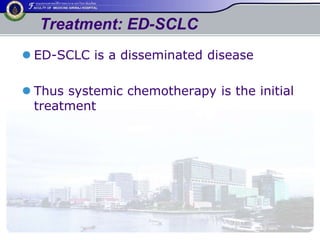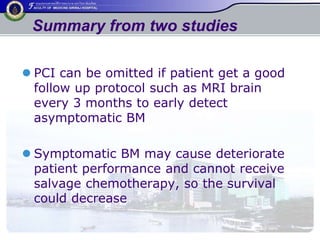Prophylactic cranial irradiation
- 1. Prophylactic Cranial Irradiation in Extensive Stage Small Cell Lung Cancer Jiraporn Setakornnukul, MD. Division of Radiation Oncology, Department of Radiology Faculty of Medicine Siriraj Hospital, Mahidol University
- 2. Outline Significance of brain metastases in SCLC PCI in ED with complete response: evidence from IPD-metaanalyses Two major RCTs : EORTC & Japanese trials Worse prognosis in asymptomatic BM ? Significant neurocognitive toxicity ?
- 3. Introduction Worldwide, lung cancer occurred in approximately 1.8 million patients in 2012 and caused an estimated 1.6 million deaths 95 % of all lung cancers are classified as either small cell lung cancer (SCLC) or non-small cell lung cancer (NSCLC)
- 4. Introduction SCLC represents about 15% of all lung cancers – Proportion of SCLC/Total lung cancer NCI Thailand (2011): 21/336 (6.25%) Siriraj Hospital (2009): 29/592 (4.9%) Nature: rapid doubling time, high growth fraction, and the early development of metastases – 70% Extensive stage – 30% Limited stage
- 5. Staging SCLC Staging SCLC by Veterans' Affairs Lung Study Group (VALSG) Limited stage: disease confine to one hemithorax or radiotherapy portal field Extensive stage: tumor beyond the boundaries of limited disease – distant metastases – malignant pericardial/pleural effusions – contralateral supraclavicular and contralateral hilar involvement
- 6. Treatment: ED-SCLC ED-SCLC is a disseminated disease Thus systemic chemotherapy is the initial treatment
- 7. Background: Treatment outcomes Response rate after combination CMT Complete response: usually around 10% Partial response: 33-45% Survival rate after combination CMT Median survival: 6.9-11.5 mo. 1yr-OS: 21-42% 2yr-OS: usually less than 5% Data from 2,580 patient SWOG data base Kathy S., JCO 1990
- 8. Why PCI is the interesting role in SCLC? Incidence of brain metastasis – At diagnosis: 10-15% – From autopsy: 35-55% Elliott JA, JCO 1987 Bunn PA, Seminars in Oncology 1978 Pattern of failure – Most common failure site: intrathoracic and CNS
- 9. Outline Significance of brain metastases in SCLC PCI in ED with complete response: evidence from IPD-metaanalyses Two major RCTs : EORTC & Japanese trials Worse prognosis in asymptomatic BM ? Significant neuocognitive toxicity ?
- 10. PCI for complete response ED-SCLC RR of death: 0.77 (0.54-1.11) RR of brain met: 0.38 (0.23-0.64) Cumulative incidence of BM at 3 yr (whole group) 33.3% for PCI and 58.6% for no PCI (Absolute decrease 25.3%)
- 11. PCI for any response ED-SCLC EORTC study from Slotman; Published in NEJM 2007 Published study Pragmatic study – Inhomogeneous patients – Clinical follow up Japanese study from Seto; Presented at ASCO 2014 Abstract only Efficacy study – Homogeneous patients – Need MRI brain follow up 2014
- 12. ED-SCLC Combination CMT With any response PCI: 20 Gy/5F, 25 Gy/8-10F, 30 Gy/10F No PCI Median time between diagnosis and randomization: 4.2 months
- 13. Primary end point: the development of symptomatic brain metastases BM 16.8% (PCI) VS 41.3% (no PCI) Absolute reduction 24.5% Relative reduction 2.46 MS 6.7 mo (PCI) VS 5.4 mo (no PCI)
- 15. Primary end point: Overall Survival BM 32.4% (PCI) VS 58% (no PCI) Absolute reduction 25.6% Relative reduction 1.79
- 16. EORTC VS Japanese trial EORTC Japanese study Population Exclude symptomatic BM Exclude both symptomatic & asymptomatic BM F/U, CNS Clinical F/U Symptomatic BM MRI F/U Mixed symptomatic & asymptomatic BM BM Absolute reduction 24.5% Absolute reduction 25.6% PFS 14.7 wk (~3.67 mo) , PCI 12 wk (~3 mo), no PCI 2.2 mo, PCI 2.4 mo, no PCI Salvage Rx outside CNS 68% in PCI 45.1% in no PCI 81% in PCI 89% in no PCI MS 6.7 mo in PCI 5.4 mo in no PCI 10.1 mo in PCI 15.1 mo in no PCI
- 17. Asymptomatic brain metastasis Asymptomatic BM response rate (CMT: cyclophosphamide, doxolubicine, and etoposide) Response rate: 27% CR rate 2/22 (9%) and PR rate 4/22 (18%) Median duration to symptomatic BM: 2.3 mo (range, 0.5-5 mo) Median survival: 8.3 mo (1.3-43.4 mo)
- 18. Summary from two studies PCI can be omitted if patient get a good follow up protocol such as MRI brain every 3 months to early detect asymptomatic BM Symptomatic BM may cause deteriorate patient performance and cannot receive salvage chemotherapy, so the survival could decrease
- 19. Neurocognitive disorder EORTC trial Role functioning, Cognitive functioning, and Emotional functioning did not different between PCI and no PCI Grosshans et al. Persistent declines in cognitive function were not observed after PCI (25Gy in 10F) in SCLC Do not favor omission PCI due to fears of neurotoxic effects Grosshans DR, Cancer 2008
- 20. Conclusion (1) ED-SCLC: Complete response after combination chemotherapy Should get PCI after CMT Data from Meta-analysis in 1999 – Gain survival benefit 5.4% – Reduce BM 25.3%
- 21. Conclusion (2) ED-SCLC: Any response (Partial response) after combination chemotherapy Good Prognosis such as single metastasis with complete systemic response – Single metastasis: better prognosis Foster NR, Cancer 2009 PCI is the standard treatment in both arms in ongoing RCT (EORTC and RTOG) – role of thoracic radiotherapy after chemotherapy
- 22. Conclusion (3) ED-SCLC: Any response (Partial response) after combination chemotherapy Moderate to poor prognosis such as multiple metastases and partial response of systemic metastasis Should receive PCI when patient cannot do regular MRI F/U






















